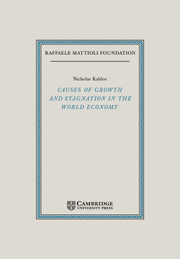Book contents
- Frontmatter
- Contents
- Preface
- Acknowledgements
- CAUSES OF GROWTH AND STAGNATION IN THE WORLD ECONOMY
- FIRST LECTURE Equilibrium Theory and Growth Theory
- SECOND LECTURE Alternative Approaches to Growth Theory
- THIRD LECTURE The Problem of Intersectoral Balance
- FOURTH LECTURE The Effects of Interregional and International Competition
- FIFTH LECTURE Policy Implications of the Current World Situation
- DISCUSSION
- NICHOLAS KALDOR, A BIOGRAPHY, by A. P. Thirlwall
- BIBLIOGRAPHY OF THE WORKS OF NICHOLAS KALDOR, compiled by Ferdinando Targetti
- BIBLIOGRAPHY OF WORKS CITED
- LIST OF ABBREVIATIONS
- INDEX
- Cambridge Cultural Social Studies
FIFTH LECTURE - Policy Implications of the Current World Situation
Published online by Cambridge University Press: 23 December 2009
- Frontmatter
- Contents
- Preface
- Acknowledgements
- CAUSES OF GROWTH AND STAGNATION IN THE WORLD ECONOMY
- FIRST LECTURE Equilibrium Theory and Growth Theory
- SECOND LECTURE Alternative Approaches to Growth Theory
- THIRD LECTURE The Problem of Intersectoral Balance
- FOURTH LECTURE The Effects of Interregional and International Competition
- FIFTH LECTURE Policy Implications of the Current World Situation
- DISCUSSION
- NICHOLAS KALDOR, A BIOGRAPHY, by A. P. Thirlwall
- BIBLIOGRAPHY OF THE WORKS OF NICHOLAS KALDOR, compiled by Ferdinando Targetti
- BIBLIOGRAPHY OF WORKS CITED
- LIST OF ABBREVIATIONS
- INDEX
- Cambridge Cultural Social Studies
Summary
This is our last lecture, and its purpose is to bring together the various threads and to apply the theoretical considerations advanced in earlier lectures to an interpretation of the current world economic situation, and the implications of this analysis for the policies required in order to restore fast growth and high employment levels to the world economy.
The post-World War II period – or more precisely, the twenty-five years elapsing between 1948 and 1973 – witnessed the most rapid, the most widespread and the most even rate of economic growth recorded in all modern history. There was no equivalent to this, either in the 19th century or in the first half of the present century. And it was no less remarkable for being so unexpected – because it was in sharp contrast to the aftermath of World War I, which witnessed a severe post-war slump, then a weak recovery, and then the greatest economic depression in history which lasted ten years. After the Second War, on the contrary, high growth rates of productivity and of real income came to be taken for granted, and when a sharp break occurred at the end of 1973, this was just as unexpected, and it took some time before the true magnitude of the change began to be grasped.
But during the twenty-five “good years”, the rate of progress was much faster than any one could have foreseen.
- Type
- Chapter
- Information
- Causes of Growth and Stagnation in the World Economy , pp. 71 - 92Publisher: Cambridge University PressPrint publication year: 1996



